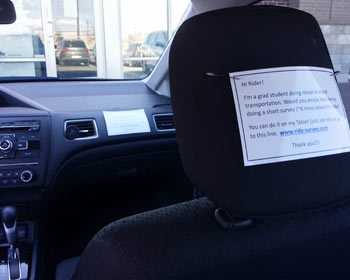Research Reports
Report Details
Abstract
 Ride-haling such as Uber and Lyft is changing the way people travel and is critical to forecasting mode choice demands and providing adequate infrastructure. Despite widespread claims that these services help reduce driving and the need for parking, little research exists on these topics. This research project uses ethnographic methods complemented with passenger surveys where one of the authors drove for Uber and Lyft in the Denver, Colorado, region to collect quantitative and qualitative data on ride-hailing. It also uses the methods to analyze the impacts of ride-hailing on deadheading, vehicle occupancy, mode replacement, vehicle miles traveled (VMT), and parking. The dataset includes actual travel attributes from 416 ride-hailing rides — Lyft, UberX, LyftLine, and UberPool — and travel behavior and socio-demographics from 311 passenger surveys.
Ride-haling such as Uber and Lyft is changing the way people travel and is critical to forecasting mode choice demands and providing adequate infrastructure. Despite widespread claims that these services help reduce driving and the need for parking, little research exists on these topics. This research project uses ethnographic methods complemented with passenger surveys where one of the authors drove for Uber and Lyft in the Denver, Colorado, region to collect quantitative and qualitative data on ride-hailing. It also uses the methods to analyze the impacts of ride-hailing on deadheading, vehicle occupancy, mode replacement, vehicle miles traveled (VMT), and parking. The dataset includes actual travel attributes from 416 ride-hailing rides — Lyft, UberX, LyftLine, and UberPool — and travel behavior and socio-demographics from 311 passenger surveys.
Section one focuses on changes in driving. The conservative (lower end) percentage of deadheading miles from ride-hailing is 40.8%. The average vehicle occupancy is 1.4 passengers per ride, while the distance weighted vehicle occupancy is 1.3 without accounting for deadheading and 0.8 when accounting deadheading. When accounting for mode replacement and issues such as driver deadheading, we estimate that ride-hailing leads to approximately 83.5% more VMT than would have been driven had ride-hailing not existed.
Section two examines relationships between parking time and parking cost. This includes building a classification tree-based model to predict the replaced driving trips as a function of car ownership, destination land type, parking stress, and demographics. Results suggest that: i) ride-hailing is replacing driving trips and could reduce parking demand, particularly at land uses such as stadiums, airports, restaurants, and bars; ii) parking stress is one of the main reasons our respondents chose not to drive themselves in the first place; and iii) our respondents are generally willing to pay more for reduced parking time and distance. Conversely, parking supply, time, and cost can all influence travel behavior and the use of ride-hailing.
Section three investigates economic opportunity that ride-hailing companies provide to drivers. Companies such as Uber and Lyft constantly promote potential earnings on the order of $25–$35 per hour. Yet, the advertised earnings do not account for factors such as time spent without passengers, the need to travel back-and-forth between areas of low and high ridership, driver residential location, or driving expenses. This chapter assesses driver earnings and estimate gross wages averaging $15.57 per hour. Given three common expense scenarios, we estimate net hourly wages ranging between $5.72 and $10.46 per hour.
Although our data collection is specific to the Denver region, this report provides insight into potential benefits and disadvantages of ride-hailing.
How to Cite
Henao, Alejandro, Wesley E. Marshall, and Bruce Janson. Impacts of Ridesourcing on VMT, Parking Demand, Transportation Equity, and Travel Behavior, MPC-19-379. North Dakota State University - Upper Great Plains Transportation Institute, Fargo: Mountain-Plains Consortium, 2019.